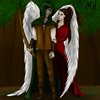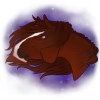Forum rules
Reminder: Copying another person's art without permission to reproduce their work is a form of art-theft!Click here to see the full Art Rules!
 by Merlin's Heir » Sun Aug 16, 2015 11:10 am
by Merlin's Heir » Sun Aug 16, 2015 11:10 am
___An eccentric multi-billionaire decided that Friesians were lacking in color. He wanted to keep the build and temperament of a Friesian, but with the white markings of other horses. And he wanted results within ten years. The horse-breeding community would have nothing to do with this, but a man named Dr. Arden, a disgraced genetic engineer, decided to take on the challenge. But Arden was disgraced for a reason; his mad ideas and strange splices had been dubbed 'crimes against nature'. He set about isolating the correct genetic code for chrome (white markings) and placing it on Friesian horses. The first batch of foals showed nothing. The Friesian gene was too dominant. The billionaire threatened to cut off Arden's funding.
___So Arden got creative. The foals that emerged were glorious; pitch black, curly-maned, and with the most exciting white markings the billionaire had ever seen. They had spots and stripes and swirls and dashes; dapples like baby deer and rosettes like panthers. They were quite extraordinary. And, for a while, all was well.
___Until the billionaire came to visit his foals one evening with a friend. And realized that their white markings glowed in the dark. He was furious, of course, but Arden soon smoothed things over, calling it a temporary measure, which would fade with age. Only, it didn't. It got brighter. And the foals grew strange but beautiful netting, under their forelegs and over their curly tails. At this point, the billionaire insisted on seeing Arden's methods. He had spliced glowing fungus genes onto horses, in the hopes of producing 'flashier' markings. The billionaire was appalled, and called for an end to the project. Arden agreed, and left.
___Not long later, strange Friesians started cropping up on the market, all with flashy white markings and netting. People were fascinated with them, and they soon became wildly popular. Before anything could be done about it, the foals were spread across the world. Breeders produced new generations of the marvelous creatures. Word got out that Arden was somehow responsible for these horses’ existence, and they were dubbed Ardenese Friesians.
___Since then, through careful selective breeding, other colors and markings have been introduced to the breed. They still retain their Friesian appearance and temperament, along with their glowing markings and netting, and black is the most commonly found color. White patterns, such as pinto and appaloosa markings, have not yet been produced, nor have the colors white or gray.
___All Ardenese Friesians have at least one glowing marking, not counting their glowing eyes and netting. Several of the more commonly seen glowing markings have been observed and named: jaguar, peacock spots, ticking, imperial, tiger, and fawn. New and never-seen-before glowing markings continually pop up, creating more and more beautiful diversity in the appearance of these majestic horses.
___First three paragraphs written by Verdana.

- Respect the staff and the community
- Do not copy this species or claim it as your own
- Do not claim an Ardenese Friesian that does not belong to you
- Do not create your own Ardenese Friesian
- You must have been on CS for 6 months and have 100 posts in the forums to adopt
- You can only adopt one Ardenese Friesian per day (this limit maybe raised in the future)
- There is currently no limit to how many Ardenese Friesians you can own
- You cannot “sell” or “give away” any of your Ardenese Friesians
- I reserve the right to refuse service to anyone or confiscate their Ardenese Friesians if I see reason to
- Ardenese Friesians have 10 breeding slots
- If you are banned, you can no longer adopt and your Ardenese Friesians will be readopted
Merlin's Heir
Owner, Artist, Moderator
Verdana
Creator, Artist

___Ardenese Friesians come in all colors and patterns except white, gray, pinto, appaloosa, and manchado. Black is the most commonly found color, and silver is the most common dilution. Many glowing markings can be found in this breed, and new ones are being discovered all the time.
___Aside from coloration and the glowing, Ardenese Friesians have all the physical characteristics of the classic Friesian horse. Thick, wavy mane and tail, powerful build, and arched necks. Their height can be anywhere in the range of 14.2-17hh, though they are usually over 15hh.
___All Ardenese Friesians have at least one glowing marking, not counting their glowing eyes or netting. It could be anything from one little cluster of peacock spots to jaguar rosettes covering nearly the entire body. Glow is only visible in the dark, and it is always duo-tone (i.e. red-orange, blue-green, etc.). All glowing markings on one horse will have the same color glow. Netting glow is always the same color as the markings' glow, but in the light it's the same color as the base coat. Eyes typically glow the same color, but are sometimes a different color. In the light, the eyes look like normal horse eyes (brown). Blue eyes (caused by white markings) glow a different color than they would if they had been brown. Blind eyes don't glow at all.
___Ardenese Friesians can only breed ten times during their life. Twins are incredibly rare, having only been found twice so far. Both foals typically survive, probably due to the breed's extra genes. Glow color is determined by genetics, so the foal will either have one of the parents' glow colors or a combination of the two. Sometimes ― very rarely, but sometimes ― a glowing marking not visible in either of the parents will be seen on the foal. As said before, new glowing markings are constantly being discovered, and the way they work is still something of a mystery, so sometimes surprises like this do pop up.

___Currently known glowing markings: Jaguar, Peacock Spots, Ticking, Imperial, Fawn, Tiger
___Jaguar looks like a white version of the rosettes on jaguars. The glowing spot in the center is only visible in the dark, so only the white lines around the outside of it are visible in the light.
___Peacock Spots look like elongated white spots in the light, but in the dark they have rings of color on the "bottom" of the spots. They are always in "clusters," often on the shoulders or hindquarters, but can be present anywhere.
___Ticking is a broken stripe-like marking that can curve and twist around. It is typically found on the face or legs, but can be anywhere. It has an uncolored glow.
___Imperial looks like thin white rings in the light, and the circle of color in the centers, separated from the white ring by a ring of the base color, only shows up in the dark.
___Fawn consists of numerous white spots on the back, shoulders, and hindquarters, with a darkening of base color beneath them. In the dark, little circles of glowing color in their centers are visible.
___Tiger resembles your typical tiger stripes, though far less in number and density. Single stripes have an uncolored glow, while split stripes reveal a color filling in the dark.
Last edited by
Merlin's Heir on Sun Aug 16, 2015 4:44 pm, edited 2 times in total.
-

Merlin's Heir
-
- Posts: 9345
- Joined: Fri Jun 03, 2011 11:51 am
- My pets
- My items
- My wishlist
- My gallery
- My scenes
- My dressups
- Trade with me
Who is online
Users browsing this forum: No registered users and 16 guests


























